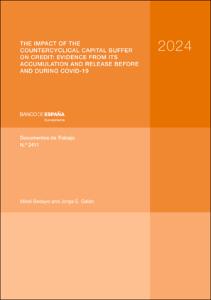The impact of the Countercyclical Capital Buffer on credit: evidence from its accumulation and release before and during COVID-19
Autor
Fecha de publicación
3-abr-2024
Descripción física
44 p.
Resumen
El colchón de capital anticíclico (CCyB, por sus siglas en inglés) se ha convertido en una herramienta macroprudencial muy importante para reforzar la resistencia de los bancos debido a su diseño anticíclico y a su posibilidad de ser liberado. Sin embargo, la evidencia sobre su impacto en el crédito a lo largo del ciclo sigue siendo limitada. Contribuimos a esta literatura proporcionando una evaluación exhaustiva de los efectos de la acumulación del CCyB en épocas de bonanza y su liberación en épocas de crisis, aprovechando el shock del COVID-19. Con datos de 170 bancos de 25 países de la Unión Europea, encontramos que el CCyB tiene efectos significativos sobre el crédito bancario, pero que estos efectos dependen en gran medida de los niveles de capitalización de los bancos y, lo que es más importante, de su margen por encima de los requisitos regulatorios. Por un lado, la acumulación del CCyB afecta negativamente al crédito, pero esto solo se observa a corto plazo y para los bancos con mayores restricciones de capital, que se enfrentan a mayores costes de capital. Sin embargo, a medio plazo, su posición de solvencia más sólida les permite reducir su coste de capital y aumentar el crédito. Por otra parte, la liberación del CCyB en respuesta a la pandemia tuvo efectos positivos sobre el crédito para todos los bancos. Sin embargo, los bancos menos capitalizados, y especialmente los que tenían menos margen sobre los requisitos, aumentaron los préstamos significativamente más que los bancos que se encontraban en mejor posición. Nuestros resultados demuestran las ventajas del CCyB, en particular a la hora de apoyar la concesión de crédito en épocas económicas adversas. Sin embargo, también ponen de manifiesto efectos heterogéneos entre bancos que las autoridades responsables deberían tener en cuenta a la hora de aplicar esta herramienta.
The countercyclical capital buffer (CCyB) has become a very important macroprudential tool to strengthen banks’ resilience. However, there is still limited evidence of its impact on lending over the cycle. Using data of 170 banks in 25 European Union countries, we provide a comprehensive assessment of how the CCyB release during the pandemic and its earlier accumulation impacted lending activity. We find that the CCyB has significant effects on lending, but that these effects are highly dependent on banks’ capitalization levels and, more importantly, on their headroom over regulatory requirements. We show that the release of the CCyB in response to the pandemic had a positive impact on lending, especially for banks with the lowest headroom over requirements, and that this effect was larger than the negative impact of its previous accumulation. While the CCyB accumulation had a short-term negative impact on lending for the most capital-constrained banks, this effect quickly diluted due to their enhanced solvency position, potentially allowing them to lower their cost of equity. Our results provide evidence of the benefits of the CCyB, especially in supporting lending during adverse events, while emphasising the need for policymakers to consider the heterogeneous effects across banks when deploying this tool.
The countercyclical capital buffer (CCyB) has become a very important macroprudential tool to strengthen banks’ resilience. However, there is still limited evidence of its impact on lending over the cycle. Using data of 170 banks in 25 European Union countries, we provide a comprehensive assessment of how the CCyB release during the pandemic and its earlier accumulation impacted lending activity. We find that the CCyB has significant effects on lending, but that these effects are highly dependent on banks’ capitalization levels and, more importantly, on their headroom over regulatory requirements. We show that the release of the CCyB in response to the pandemic had a positive impact on lending, especially for banks with the lowest headroom over requirements, and that this effect was larger than the negative impact of its previous accumulation. While the CCyB accumulation had a short-term negative impact on lending for the most capital-constrained banks, this effect quickly diluted due to their enhanced solvency position, potentially allowing them to lower their cost of equity. Our results provide evidence of the benefits of the CCyB, especially in supporting lending during adverse events, while emphasising the need for policymakers to consider the heterogeneous effects across banks when deploying this tool.
Publicado en
Documentos de Trabajo / Banco de España, 2411
Materias
Crédito bancario; Colchones de capital; COVID-19; Política macro-prudencial; Regulación de capital; Bank credit; Capital buffers; COVID-19; Macroprudential policy; Capital regulation; Bancos; Supervisión financiera; Regulación y supervisión de instituciones financieras; Países de la UE
Aparece en las colecciones:












